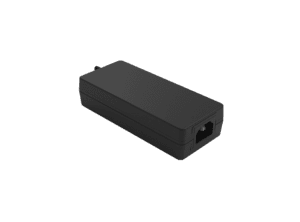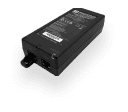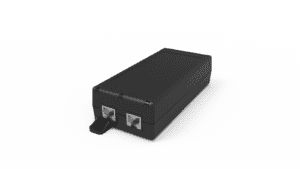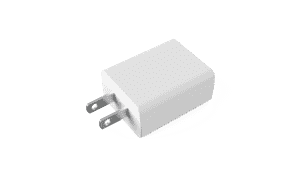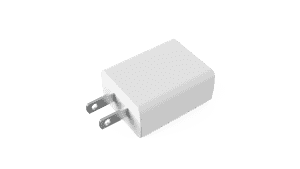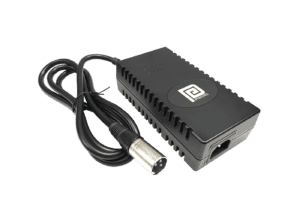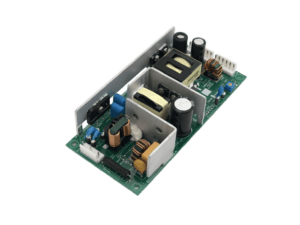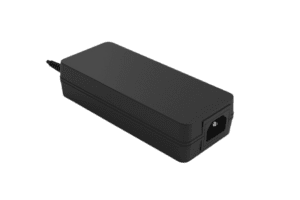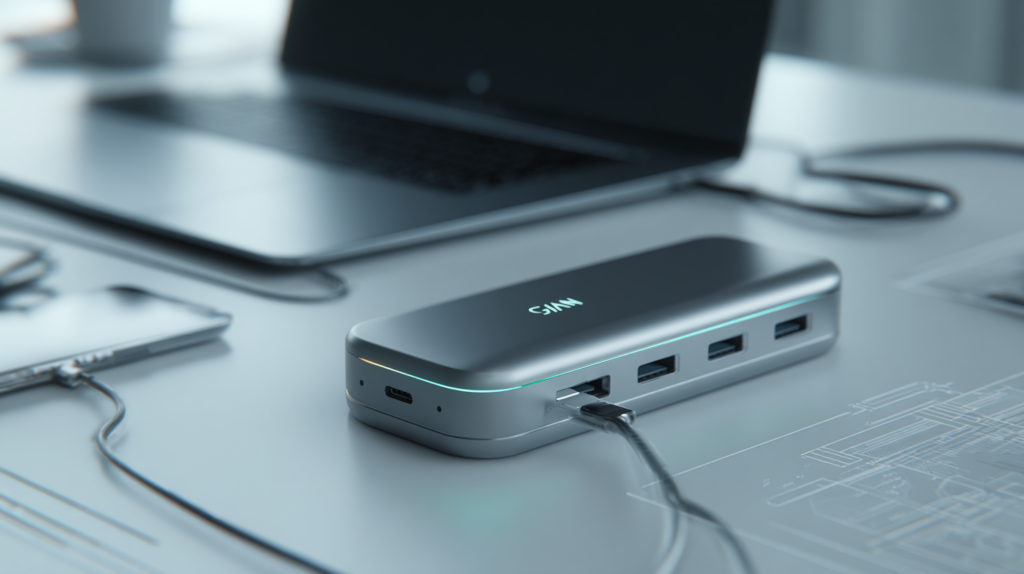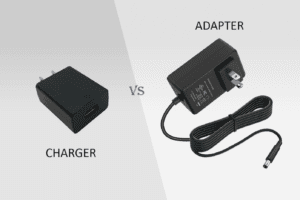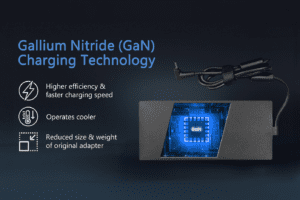BLOG
USB-C PD 3.2 Adapter Manufacturer: How to Produce 280 W GaN Chargers for AI-Ready Laptops
Table of contents
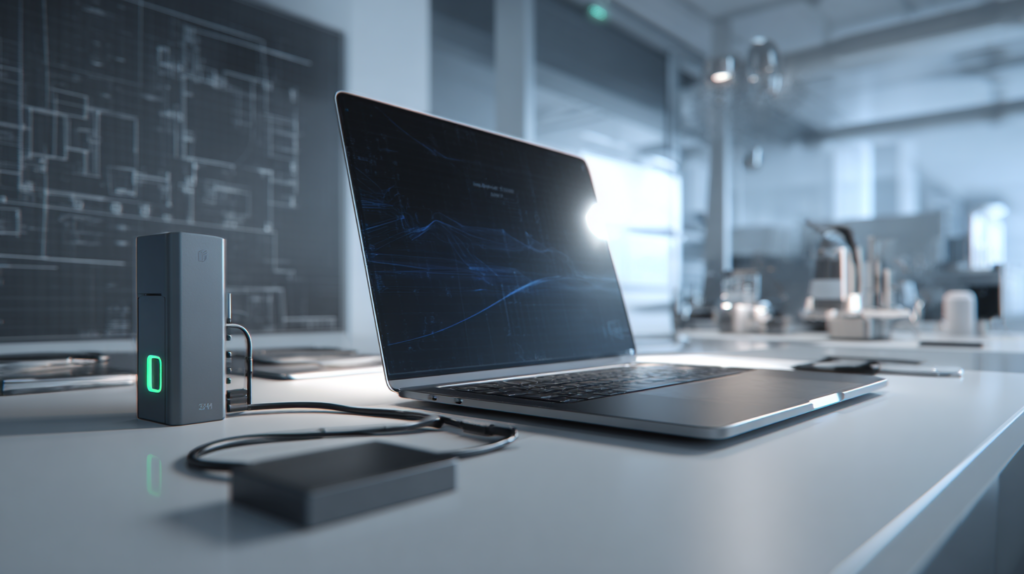
Why AI-Ready Laptops Demand 280 W USB-C PD 3.2 Chargers
As AI-focused mobile workstations, gaming laptops, and data-science-grade portable machines continue to evolve, their power demands are far beyond what traditional laptop adapters can handle. AI-ready laptops, often equipped with high-performance GPUs like NVIDIA RTX 4090 mobile or Apple M-series chips with dedicated NPUs, now require 200–300 W of sustained power to operate at full performance without throttling.
Enter USB-C Power Delivery (PD) 3.2—the latest standard capable of pushing up to 48 V at 5.8 A (280 W) over a single reversible USB-C connector. Combined with GaN (Gallium Nitride) semiconductor technology, manufacturers can now produce compact, ultra-efficient chargers that deliver massive power in a form factor suitable for travel and enterprise deployment.
This new generation of adapters supports:
- Ultra-fast charging
- Parallel device power (e.g., laptop + peripherals)
- Peak GPU performance during AI inference or training workloads
Top Features
- USB-C PD 3.2 Extended Power Range (EPR) support (up to 280 W)
- 48 V output with PPS (Programmable Power Supply) negotiation
- GaN-based compact architecture with high thermal efficiency
Top Benefits
- Enables full performance for mobile AI workstations
- Consolidates charging for laptops, monitors, and accessories
- Reduces travel footprint for power-hungry professionals
Best Practices
- Ensure firmware compliance with PD 3.2 and PPS behavior
- Validate compatibility with high-speed USB-C e-marker cables
- Include smart load detection to distribute power across ports
This isn’t just about faster charging—it’s about delivering workstation-class power in a portable, standards-compliant form factor.
Engineering GaN-Based High-Power Chargers for USB-C PD 3.2
To deliver 280 W in a size comparable to a traditional 100 W adapter, manufacturers must utilize GaN technology. GaN transistors allow chargers to switch at much higher frequencies than silicon, reducing the size of magnetics, heat sinks, and the overall PCB footprint.
GaN-based PD 3.2 adapters use:
- High-frequency flyback or LLC resonant topologies
- Secondary-side synchronous rectification
- Integrated PFC and EMI filters for global market compliance
The thermal profile of these chargers must be carefully managed using:
- Multi-layer PCB with copper pour for heat dissipation
- Thermally conductive enclosures (e.g., anodized aluminum)
- Smart temperature derating logic to protect internal components
Firmware also plays a crucial role. It must:
- Detect host capabilities and switch between 20 V, 28 V, 36 V, or 48 V profiles
- Negotiate PPS (e.g., 28 V @ 5 A, 48 V @ 5.8 A)
- Enforce load shedding or port prioritization under thermal or power constraints
Top Features
- GaN power stage with >94% efficiency at full load
- Compact form factor: <300 cc with 280 W output
- PD 3.2 firmware with programmable current steps
Top Benefits
- Smaller, cooler, and more efficient than silicon-based designs
- Reduces BOM complexity through integrated control ICs
- Meets global energy efficiency and thermal safety standards
Best Practices
- Validate thermal performance using CFD and real-world use cycles
- Use digital control ICs for load monitoring and power path management
- Include OTP, OCP, OVP, and UVLO protections in firmware
The future of AI laptop charging is light, fast, and GaN-powered—but only when the power stage, control loop, and enclosure all work in perfect harmony.
CLIENT'S QUOTE
"Phihong’s PoE solutions have made a huge difference for us! Our network runs more efficiently, and we’ve seen real cost savings. We couldn’t be happier!"
Designing for Thermal Performance and Compliance at 280 W
High-wattage adapters face unique thermal challenges. Unlike 65 W or 100 W chargers, 280 W units generate significant heat, especially under sustained AI processing loads. Maintaining safety and compliance while keeping the unit compact requires advanced thermal and mechanical design strategies.
Key thermal management tactics include:
- Using high-conductivity GaN substrates and copper planes
- Thermally conductive potting or gap filler materials between PCB and housing
- Fanless design with external finned aluminum casings
From a compliance perspective, the adapter must meet:
- UL 62368-1 / IEC 62368-1 for safety
- DOE Level VI / CoC Tier 2 for efficiency
- FCC Part 15B / EN 55032 for EMI
The design must also comply with USB-IF EPR certification, including the ability to handle up to 50 V surge testing and proper behavior during PD negotiation failures.
Top Features
- Passive cooling design with 5–8°C ambient headroom
- EMI shielding and integrated common-mode chokes
- Conformal-coated PCB for increased durability
Top Benefits
- Extends charger lifespan and reduces thermal shutdown risk
- Simplifies global certification and retail readiness
- Increases user confidence and brand trust
Best Practices
- Use thermal simulation in enclosure design phase
- Include multi-point temperature monitoring for hot spot detection
- Design to derate cleanly at >40°C ambient use
When done right, a 280 W GaN adapter can stay cool, compliant, and compact—even under the harshest AI workloads.
USB-C Cable and Connector Requirements for 280 W Charging
Delivering 280 W over USB-C requires both ends of the connection to be certified and capable. USB PD 3.2 EPR mandates use of certified e-marker cables capable of 50 V / 5 A, and connectors that meet mechanical and thermal safety standards.
Connector and cable requirements include:
- USB-C plugs rated for 50 V, 5.8 A continuous
- E-marker chips that support 240 W–280 W negotiation
- Flame-retardant and heat-resistant insulation (UL 94 V-0)
The adapter firmware must detect the e-marker chip and validate the cable’s current and voltage handling before enabling EPR levels. If the cable is non-compliant or missing the e-marker, the charger must drop to a safer, lower PD profile (e.g., 20 V @ 3 A).
Cables must also minimize resistance to prevent voltage drop at high current. For a 48 V, 5.8 A load, even a slight increase in impedance can result in thermal rise or inefficient power delivery.
Top Features
- USB-IF certified connectors and cables
- Low-resistance, tinned copper wire with >100 W/cm³ current density
- Durable plug-shell design for repeated insertions
Top Benefits
- Prevents overheating, connector melting, or damage
- Ensures safe, stable charging across all PD profiles
- Increases compatibility across devices and accessories
Best Practices
- Bundle high-power adapters with tested, certified cables
- Warn users not to substitute non-rated cables
- Include firmware-based fallback to lower PD levels when needed
No matter how advanced your charger is—it’s only as good as the cable that connects it.
Integrating Intelligent Charging Firmware and Safety Protocols
High-power USB-C adapters must be smart enough to negotiate power safely and react to abnormal conditions. This means integrating advanced firmware into the power controller and charger microcontroller to manage load requests, profile switching, and fault response.
Essential firmware capabilities:
- PD 3.2 protocol stack with PPS and EPR negotiation
- Thermal throttling and fan or current derating logic
- Power-on sequencing and watchdog fault recovery
The firmware must be able to:
- Confirm device capabilities and initiate safe charging
- Switch between profiles based on real-time current demand
- Interrupt charging and notify host in case of overvoltage, undervoltage, or thermal failure
In multi-port adapters, the firmware must also:
- Prioritize ports based on device type or current draw
- Reallocate unused wattage dynamically
- Prevent race conditions or unstable PPS switching
Top Features
- Embedded controller with USB PD stack and safety interrupt logic
- Secure firmware update capability via USB or debug header
- Fault memory and diagnostics logging
Top Benefits
- Prevents charger or device damage during extreme conditions
- Enables long-term firmware upgrades or performance tuning
- Meets USB-IF compliance and end-device validation
Best Practices
- Develop firmware using USB-IF certified PD libraries
- Perform PPS load-switching stress tests
- Store usage logs for field diagnostics and support
Firmware makes the difference between a high-power brick and a true smart AI laptop charger.
How Phihong USA Supports USB-C PD 3.2 GaN Adapter Manufacturing
Phihong USA supports global OEMs in developing next-generation USB-C PD 3.2 power adapters for AI laptops, creative workstations, and mobile compute platforms. With decades of experience in power electronics, we offer full-stack engineering—from GaN power stage design to firmware development and connector compliance.
We provide:
- PD 3.2-compliant adapter platforms (240 W to 300 W)
- High-efficiency GaN topologies with 94–96% performance
- Thermal-optimized enclosures and passive cooling strategies
- Smart firmware with PPS, load monitoring, and USB-C negotiation
- Cable and connector matching services with certified e-marker assemblies
- Certification prep for USB-IF, UL, CE, FCC, and RoHS
Whether you’re upgrading an existing USB-C design or launching a flagship AI laptop with 280 W needs, Phihong delivers compact, certified, and scalable power platforms.
To discuss OEM development, request engineering samples, or explore integration services, contact usasales@phihongusa.com or visit www.phihong.com.

Contact Our Team Today!
Our dedicated sales team and international partners are prepared to support you with your latest projects and initiatives globally.
Explore More with Phihong USA
As we conclude our exploration of PoE technology, it’s evident how these innovations are streamlining power and data integration across various industries. Phihong USA stands at the forefront of this technological advancement, offering a diverse range of power solutions designed to meet the evolving needs of modern industries.
Phihong USA’s extensive product lineup includes:
- Power over Ethernet (PoE) Solutions: Delivering reliable power and data transmission over a single cable, ideal for simplifying network installations and reducing costs.
- AC/DC Adapters and Power Supplies: From compact adapters to industrial-grade power supplies, Phihong provides solutions that ensure efficiency and reliability in various applications.
- Battery Chargers: Customizable chargers for lithium-ion and lead-acid batteries, supporting a wide range of power requirements for mobility and industrial applications.
- Medical Power Supplies: Specialized power solutions designed to meet the stringent requirements of the healthcare industry, ensuring safety and reliability.
Phihong USA is committed to innovation and excellence, continually developing products that meet the highest standards of performance and reliability. Their global reach and dedication to customer support make them a trusted partner in powering the future.
Here are some useful links to explore Phihong USA’s offerings further and bring in new potential clients:
Visit Phihong USA to discover how their advanced power solutions can support your business needs. Whether you’re looking to upgrade your network, or find reliable power supplies, Phihong USA has you covered.
By choosing Phihong USA, you’re partnering with a leader in power technology, ensuring your operations run smoothly and efficiently with top-tier power solutions. Contact Us today!
FAQ
What is USB-C PD 3.2 and how is it different from PD 3.0?
USB-C PD 3.2 is the newest version of the USB Power Delivery standard and introduces support for Extended Power Range (EPR)—allowing chargers to deliver up to 240–280 W through a USB-C connector. PD 3.0 was limited to 100 W (20 V @ 5 A), while PD 3.2 expands the voltage to up to 48 V and current to 5.8 A, enabling high-performance laptops and AI workstations to be fully powered via USB-C.
Why use GaN in high-power adapters?
GaN (Gallium Nitride) semiconductors offer superior efficiency, switching speed, and thermal performance compared to traditional silicon components. In high-power USB-C chargers (240–280 W), GaN allows the adapter to be smaller, cooler, and more energy efficient, with less heat and lower EMI. Phihong uses GaN to reduce PCB size, shrink enclosures, and increase reliability without adding fans.In addition to the aforementioned benefits, the use of
GaN technology also facilitates advancements in charging speeds and power delivery profiles. With more efficient power conversion and reduced heat generation, GaN-based adapters can sustain higher power outputs for longer durations, enabling faster charging for devices. This is particularly crucial for demanding devices like high-performance laptops and workstations that require substantial power to operate and charge simultaneously. Furthermore, the precision control offered by GaN semiconductors allows for dynamic adjustment of power delivery based on device needs, optimizing charging efficiency and preventing overcharging or damage. This adaptability ensures a reliable and tailored power solution for a wide range of electronic devices, further solidifying GaN’s position as a leading technology in modern power adapter design.
What cable do I need for a 280 W USB-C charger?
You must use a USB-IF certified e-marker cable rated for 50 V and at least 5 A. Most standard USB-C cables are only rated for 3 A or 20 V. Using an incorrect cable may prevent the charger from delivering EPR-level power or could lead to overheating. Always bundle or recommend a certified 240–280 W cable with every high-power adapter.To safely and effectively use a 280W USB-C charger, selecting the right cable is critical. The required cable is a USB Implementers Forum (USB-IF) certified e-marker cable, specifically designed to handle the high power delivery of such chargers. This cable must be rated for 50 volts (V) and a minimum of 5 amperes (A).
It’s important to understand that most standard USB-C cables do not meet these specifications. Typically, these general-purpose cables are only rated for 3A or 20V, which is insufficient for a 280W charger. Using an under-rated cable can have serious consequences. Firstly, it may prevent the charger from delivering its full Extended Power Range (EPR) capabilities, leading to slower charging or an inability to power high-demand devices. More concerningly, using an incorrect cable can cause overheating, potentially damaging the cable, the charger, and the connected device.
To ensure safe and optimal performance, it is crucial to always bundle or explicitly recommend a certified 240–280W cable whenever selling or providing a high-power adapter. This practice guarantees compatibility, prevents potential hazards, and ensures that users can take full advantage of the charger’s power delivery capabilities. By emphasizing the importance of using the correct, certified cable, you protect both the user and the equipment from potential damage and operational issues.
Is PD 3.2 backward compatible?
Yes. USB PD 3.2 chargers automatically negotiate lower profiles with PD 3.0 or PD 2.0 devices. For example, a 280 W PD 3.2 charger can still safely power a 100 W laptop or a 65 W phone, switching to the appropriate profile (e.g., 20 V @ 5 A or 15 V @ 3 A). However, the host device and cable must support EPR to unlock full 280 W capability.
How does Phihong help with USB-C PD 3.2 adapter design?
Phihong provides full engineering support, including:
- GaN power supply architecture
- USB PD 3.2 and PPS firmware development
- Connector + cable matching
- Enclosure design and thermal simulation
- Pre-compliance testing for USB-IF and global certifications
We help OEMs bring high-performance, AI-ready USB-C adapters to market faster—with confidence in safety, size, and scalability.

